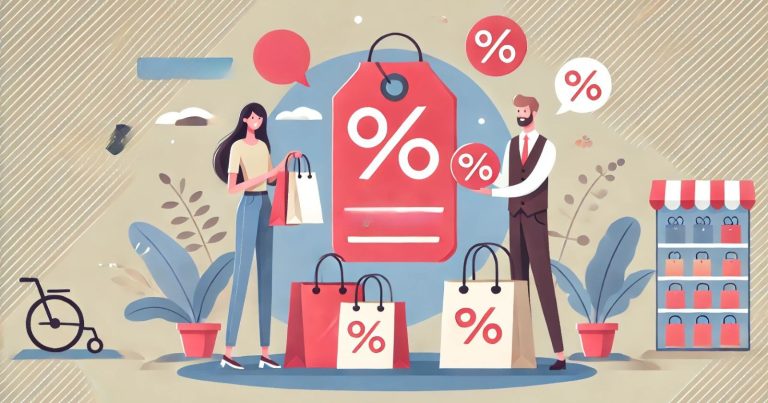Sales promotion is a promotional technique that increases sales by providing discounts, incentives, or short-term offers to motivate customers to purchase and raise demand. Different types of sales promotion enable companies to increase sales, acquire new customers, and retain current customers. Sales promotions are temporary marketing endeavours that incentivise consumers to purchase a product or service. Organizations apply sales promotion techniques, including coupons, discounts, free samples, and contests, to stimulate demand and generate brand consciousness.
What is Sales Promotion?
Sales promotion is a form of marketing that motivates customers to buy a product. These promotions can be price cuts, giveaways, contests, or rewards. Sales promotion differs from traditional advertising because it seeks to stimulate instant demand and increase short-term sales. For instance, A firm that gives a Buy One Get One Free (BOGO) offer on soft drinks makes customers purchase more than they initially planned to.
Why Do Companies Do Sales Promotions?
Companies can utilize sales promotions to generate a number of marketing and business goals. Sales promotions are more of a short-lived thing, be it launching a new product or clearing out old inventory, they help businesses bring in quick revenue as well as engage customers.
- Boost Immediate Sales: Promotions generate a sense of urgency and encourage impulse buying. Time-sensitive offers and promotions force consumers to make rapid purchasing decisions. Businesses use flash sales and special offers to create short-term revenue spikes.
- Attract New Customers: Discounts and offers allow first-time buyers to sample a brand. This is why businesses offer free trials and sample giveaways to new customers. Developed a Successful Promotion: A successful promotion builds brand awareness and attracts additional buyers.
- Sticky Customers: Loyalty programs and cashback offers retain customers. Follow-up with repeat buyers on special promotions to develop a strong customer relationship. When customers feel valued and have long-term engagement, personalized offers will make them come back for more.
- Stay Ahead of Rivals: Brands showcase competitive pricing and promotions. Providing superior deals than the rivals leads to greater sales. # Brands leverage exclusive price cuts and unique rewards to capture the market.
- Introduce New Products: Introductory discounts or free samples help raise awareness of products to boost sales. Customers are more likely to experiment with new offerings if they perceive a price advantage. Businesses use promotional offers to solicit feedback and better fit with the product.
- Shift Excess Inventory: Seasonal markdowns and stock liquidation help to clear out end-of-season inventory. Discounting stale inventory opens up shelf space for new products. Businesses use end-of-season sales as an incentive for bargain shoppers to boost sales.
Different Types of Sales Promotion
Types of Sales Promotion assist firms in attracting new consumers, enhancing sales, and establishing brand loyalty. Various promotions cause excitement and drive individuals to impulse buying decisions.
Discounts and Price Promotions
Retailers give discounts to draw in customers and increase sales. Discounts can also be percentage-off deals, buy-one-get-one (BOGO) offers or flat-rate price cuts. These promotions foster urgency, motivating users to purchase before the offer ends. Seasonal sales, festival discounts, and clearance sales are great ways for businesses to sell last year’s inventory and generate additional breaking-through income.
Coupons and Promo Codes
Coupons and promo codes provide customers with a discount when they buy something. Companies send them out via websites, emails, social media or print advertisements. Shoppers apply these during checkout and save immediately. This technique boosts sales, and at the same time, it enables companies to track customer behaviour. Digital coupons promote online purchases as well as repeat transactions.
Cashback Offers
Cashback promotions return a segment of the formation amount after the consumer purchases a product. Companies use this technique to boost customer retention and promote recurring commerce. Cashback rewards are also good for online and credit card payments. These types of deals appeal to customers looking to gain something meaningful beyond a discount at the point of purchase.
Free Samples and Trial Offers
Businesses offer free samples to allow customers to experience a product before purchasing. This approach is a good way to build when the product is new. After experiencing the quality of the product firsthand, customers are more likely to make a purchase. Digital good and free service trials convert potential buyers into paying customers in the long run.
Loyalty Programs
Loyalty programs get customers to buy twice. Businesses reward customers who come in often with points, discounts, or exclusive offers. Customers can use those points to receive future discounts or free products. From the marketing perspective, loyalty programs create good relationships between customers and businesses, which increases the retention rate. Brands leverage membership programs to serve personalized offers and retain customers.
Limited-Time Offers
Customers benefit from a sense of urgency with time-limited promotions, encouraging them to make quick purchase decisions. Instant buys, quickly expiring offers, and limited-time markdowns give shoppers the sense they will lose out if they don’t purchase immediately. This kind of sales typically are effective for e-commerce sites and holiday sales. This leads to higher conversions over time due to the fear of missing out.
Contests and Giveaways
Contests and giveaways, businesses use contests and giveaways to engage customers and promote their brands. Customers engage by doing things such as sharing posts, tagging friends, or answering questions. To enter simply take a picture showing the product with an interesting background and you could win free products or discounts. This method exponentially raises brand awareness, creates a social media buzz, and brings customers in the door at little to no cost in advertising.
Objectives of Sales Promotion
They are among the most effective and widely used marketing strategies to increase sales, acquire new customers, and develop brand loyalty. These short-term strategies are vital to ensuring you are seen and engaged by your customers. We can say that sales promotions are the backbone of business growth.
- Creating Demand for New Products: Launching a product in a competitive market is difficult. Discounts, free trials, special offers and other sales promotions can bring in first-time buyers and build a brand.
- Staying Competitive: Brands need to be different in the market. Limited-time discounts, flash sales, and exclusive deals create urgency, boost sales, and prevent customers from switching to competitors.
- Establishing Credibility: Customers trust you more when you have a higher sales volume. We will educate you on everything you should know regarding sales promotions, including how to leverage them to construct a known brand and sell more items while earning credibility through them.
- Increased Brand Awareness: Customers respond to incentives. Overall, giveaways, referral programs, and exclusive discounts will improve brand visibility, driving word-of-mouth marketing and leading to more buyers.
- Customer Retention: Retaining existing customers is crucial to attracting new customers. Repeat purchases are encouraged, and customer relationships are strengthened through loyalty programs, cashback offers, and special deals.
- Increase sales in off-seasons: Some products are sold more in some specific seasons. Clearance sales, bundled offers, discounts, etc., help businesses maintain a steady revenue stream during the lean seasons and avoid excess inventory.
Sales Promotion Techniques
Accurate sales promotion is essential to drive your customers and increase sales through effective sales promotion. In short, by knowing your audience, creating urgency and ensuring that promotions fit your brand, you can maximise their impact.
- Know Your Audience: Take some time to consider who you will be targeting before you activate a sales promotion. Are you enticing new customers or rewarding loyal ones? Are you looking to bring awareness around a new product or increase sales of an existing one? These questions help you determine which promotion strategies are best for your business.
- Urgency and Scarcity: A sales promotion should have a clearly defined deadline or limited product availability. FOMO (Fear of Missed Opportunity) customers are likelier to buy when they fear they’ll miss out. Leverage Time-Sensitive Offers or Exclusive Deals
- Keep Your Promotion Aligned with Your Brand: Make sure your sales promotions align with your business model. If your long-term sale products are like electronics, providing a subscription service won’t make sense. Instead, prioritize extended warranties, upgrade discounts, or trade-in offers that match your customer’s buying cycle.
Different Sales Strategies
Companies employ various marketing strategies to bring customers and generate sales. The three most prominent approaches are pull, push, and hybrid methods, which assist companies in generating demand, marketing products, and targeting their audience efficiently.
Pull Strategy
A pull strategy involves generating product demand and directing customers towards it. Companies use ads, discounts, buy-one-get-one offerings and time-limited offers to make their products attractive. The hope is to get customers to reach out in droves, boosting brand awareness and sales. This works best when companies have strong marketing campaigns that generate excitement and brand love from consumers. Pull strategies enable companies to create relationships with customers that last longer as they gain brand recognition.
Push Strategy
The Push strategy is about actually taking the product to the customer. Businesses rely on sales teams, in-store promotions, and incentives to get their products in front of potential customers. This approach enables businesses to launch new products and find customers who might not be actively looking for them. Examples of push strategies include retail displays, trade shows, and direct selling. This approach drives immediate sales and builds market presence for companies.
Hybrid Strategy
A hybrid strategy incorporates elements of both push and pull strategies to optimize sales and reach a broad audience. When it comes to promoting products, companies often use push techniques such as direct selling and promotions to make products available to customers and pull methods such as advertising and discounts to generate demand. With this balanced approach, businesses can push sales from all angles and cover the market better. Hybrid strategies typically suit brands that seek to improve product exposure & develop solid consumer demand.
Types of Sales Promotion FAQs
1. How is advertising different from sales promotion?
Advertising generates brand awareness, whereas sales promotion induces prompt purchases with incentives such as discounts and offers.
2. What are the advantages of sales promotions?
Sales promotions boost sales, acquire new customers, clear stock, and enhance customer loyalty.
3. What are the disadvantages of sales promotions?
Regular promotions decrease profit margins, devalue the brand, and make customers dependent on discounts.
4. What effect do sales promotions have on consumer behavior?
They stimulate impulse purchases, bring in price-conscious consumers, and increase brand interaction.
5. How can businesses balance advertising and sales promotion?
Firms must integrate long-term branding activities with short-term promotions for optimal effect.


